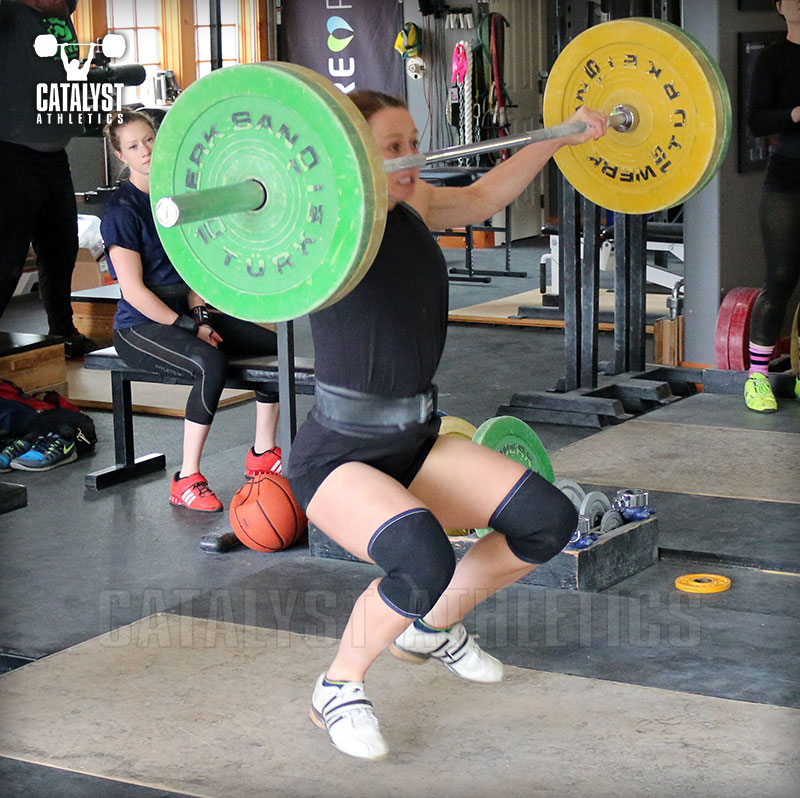Ask Greg: Issue 163

Mira asks: In the snatch, I feel like I have a slow turn over, like I always seem to sneak underneath the bar when receiving the bar overhead. Are there drills I can use to train this aspect outside of tall snatches from the hip? Are there any cues you can recommend? What are your thoughts on hang snatches to help this issue?
Greg says: This is actually a trickier issue than it may appear to be because I don’t know how accurate your perception of what’s happening is—it’s common for athletes to misdiagnose based on what they feel. In this case, for example, it may be that your turnover speed is fine, but you’re beginning it too late, or that you’re overextending in the second pull, which then starts you off at a disadvantage regardless of your actual turnover speed and effort. And your describing it as “sneaking under the bar” also makes me wonder if it’s actually more an issue of failing to adequately accelerate and elevate the bar prior to the turnover, in which case no amount of speed in the turnover will solve the problem.
For turnover speed directly, tall snatches are the best exercise. It sounds like you’re not finding them effective (enough), so if that’s true, either you’re not doing them properly, or the problem isn’t really the turnover. Let’s assume it’s the latter.
This means the issue is more related to the second pull and getting adequate acceleration and elevation at the top of your pull, and likely the transition and timing into the third pull as well. In this case, you need to drill that motion, i.e. use exercises that emphasize both the final upward extension and the pull under as one action.
Hang snatches are a good option, but of course, how you perform them will make all the difference. At least initially, the higher the hang position (mid-thigh and higher), the better, to force an aggressive and more complete extension, and a quick transition and pull under. Make sure you begin with weights you’re confident with and can perform the lift well before trying to go heavier. If you rush into heavier weights, you’re going to do the same thing you’re doing now and simply reinforce the problem.
I would start with snatch from power position—because you start with the trunk vertical, it’s much easier to reach a fully extended position; in a hang snatch from mid- or upper-thigh lift, it’s easier to end up just snapping the hips partially rather than driving and opening up completely.
Another good exercise would be a 3-position snatch starting at the floor, then from the knee, and then from mid-thigh—you can also do floor, mid-thigh and upper-thigh. This gets you the hang positions, but it also tends to force more aggression since each subsequent rep is done with a bit more fatigue but gives you less distance and time to do the work.
Greg says: This is actually a trickier issue than it may appear to be because I don’t know how accurate your perception of what’s happening is—it’s common for athletes to misdiagnose based on what they feel. In this case, for example, it may be that your turnover speed is fine, but you’re beginning it too late, or that you’re overextending in the second pull, which then starts you off at a disadvantage regardless of your actual turnover speed and effort. And your describing it as “sneaking under the bar” also makes me wonder if it’s actually more an issue of failing to adequately accelerate and elevate the bar prior to the turnover, in which case no amount of speed in the turnover will solve the problem.
For turnover speed directly, tall snatches are the best exercise. It sounds like you’re not finding them effective (enough), so if that’s true, either you’re not doing them properly, or the problem isn’t really the turnover. Let’s assume it’s the latter.
This means the issue is more related to the second pull and getting adequate acceleration and elevation at the top of your pull, and likely the transition and timing into the third pull as well. In this case, you need to drill that motion, i.e. use exercises that emphasize both the final upward extension and the pull under as one action.
Hang snatches are a good option, but of course, how you perform them will make all the difference. At least initially, the higher the hang position (mid-thigh and higher), the better, to force an aggressive and more complete extension, and a quick transition and pull under. Make sure you begin with weights you’re confident with and can perform the lift well before trying to go heavier. If you rush into heavier weights, you’re going to do the same thing you’re doing now and simply reinforce the problem.
I would start with snatch from power position—because you start with the trunk vertical, it’s much easier to reach a fully extended position; in a hang snatch from mid- or upper-thigh lift, it’s easier to end up just snapping the hips partially rather than driving and opening up completely.
Another good exercise would be a 3-position snatch starting at the floor, then from the knee, and then from mid-thigh—you can also do floor, mid-thigh and upper-thigh. This gets you the hang positions, but it also tends to force more aggression since each subsequent rep is done with a bit more fatigue but gives you less distance and time to do the work.
| Greg Everett is the owner of Catalyst Athletics, publisher of The Performance Menu Journal and author of Olympic Weightlifting: A Complete Guide for Athletes & Coaches, Olympic Weightlifting for Sports, and The Portable Greg Everett, and is the writer, director, producer, editor, etc of the independent documentary American Weightlifting. Follow him on Facebook here. |
Search Articles
Article Categories
Sort by Author
Sort by Issue & Date
Article Categories
Sort by Author
Sort by Issue & Date

